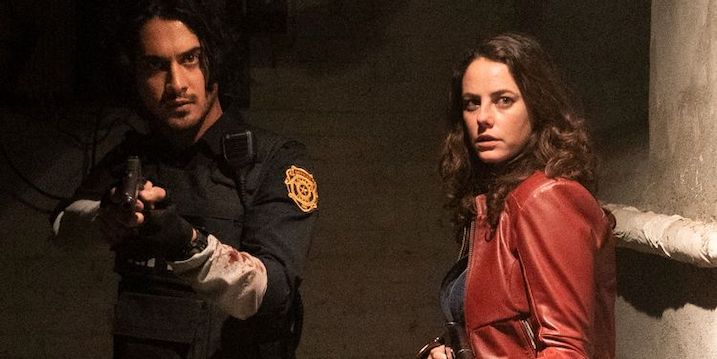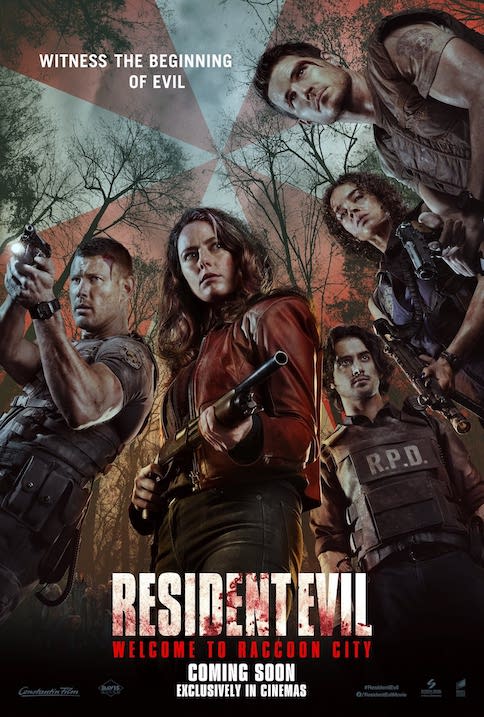‘Welcome to Raccoon’ City Is ‘Resident Evil Fan Fiction (Movie Review)
 Opening exclusively in theaters, Resident Evil: Welcome To Raccoon City is the seventh live-action feature based on Capcom’s survival horror videogame series. Sony Pictures is relaunching a movie version just in time for the 25th anniversary of the Umbrella Corporation’s unhealthy obsession with turning the citizens of Raccoon City into zombies. Unlike the Milla Jovovich-led films by Paul W.S. Anderson, which grossed over 1.2 billion, 2021’s entry is a more faithful adaptation of the first two Resident Evil games. Both debuted on the original PlayStation in the 90s (Resident Evil 2 was recently remade in glorious 4K for the PS4 era). Will Crawl‘s Kaya Scodelario be the big screen Claire Redfield fans have been clamoring for? She definitely has a red leather jacket, so that’s a start, right?
Opening exclusively in theaters, Resident Evil: Welcome To Raccoon City is the seventh live-action feature based on Capcom’s survival horror videogame series. Sony Pictures is relaunching a movie version just in time for the 25th anniversary of the Umbrella Corporation’s unhealthy obsession with turning the citizens of Raccoon City into zombies. Unlike the Milla Jovovich-led films by Paul W.S. Anderson, which grossed over 1.2 billion, 2021’s entry is a more faithful adaptation of the first two Resident Evil games. Both debuted on the original PlayStation in the 90s (Resident Evil 2 was recently remade in glorious 4K for the PS4 era). Will Crawl‘s Kaya Scodelario be the big screen Claire Redfield fans have been clamoring for? She definitely has a red leather jacket, so that’s a start, right?

The first Resident Evil was released in 1996, which, coincidentally, is the same year Purdue Pharma unleashed OxyContin to the market. Over the past twenty years, Purdue, the infamous Sackler family’s privately-owned company, unleashed an all too real opioid epidemic (Over 800,000 Americans have died). There was no way Capcom’s sci-fi horror tale of corporate greed was meant to be analogous to an actual pharmaceutical company back in the 90s, but boy, things have changed.
Set in September 1998, one of the most ingenious aspects of the reboot is having Claire Redfield (Scodelario) witness firsthand how the unregulated Umbrella Corporation has destroyed the once peaceful town of Raccoon City. On display everywhere are the remnants of a run-down city with people on the brink of withering away. The rumor by the locales is that Umbrella put something in the water. Unlike Purdue Pharma’s devastation of a small Appalachian town with prescription meds that effectively turned patients into addicts, Umbrella didn’t need doctors to push pain relief to enact their nefarious plan. However, they did use clever marketing, placing the ubiquitous Umbrella logo on billboards, television commercials, etc. You get it.
In a year where Hulu’s Dopesick explored the compelling and tragic account of the opioid epidemic starring award-winning actors like Michale Keaton, Welcome To Racoon City is surely its zombie-infested B movie cousin. There are more undead zombies on screen than a Spotlight-like investigation, yet the villain is all too similar as wild conspiracies blur the truth behind Umbrella’s lies. This is, after all, still Resident Evil. The plot will undoubtedly get too convoluted. However, the body count will be easy to follow, and many gross-out creatures should be expected.

Alas, beyond what is admittedly a strong way to make the story relevant, director Joannes Roberts is out of his element. 47 Meters Down (his previous hit) succeeded by focusing the story on two women, a rickety cage, and hungry sharks. Welcome to Raccoon City has way more moving parts that often look cheap and undercooked. While the latest remakes of the games are triumphs of set design and crisp art direction, the film appears lower in budget, even compared to Anderson’s original from 2002. Could Roberts have made a better film with a bigger budget? Probably not. There’s a fundamental difference between exploring a game’s level and seeing it in the passive format of cinema. Roberts doesn’t offer much beyond situations born from fan fiction than any kind of coherence to the narrative. Moments happen with little to sense that the plot is going anywhere beyond the mayhem of killing monsters, and poorly at that.
Fans of the games will no doubt relish seeing their favorite characters like Claire, Leon S. Kennedy, and Jill Valentine unload ammo on those plagued with the T-Virus (Although it should be noted that it’s not as quite as fun now that we’re aware these are innocent working-class people). Still, there are plenty of easter eggs. My favorite was the “Jill sandwich” line of dialogue delivered by Hannah John-Kamen as the tough but fair Jill Valentine.
The cast is surprisingly good in Anderson’s films, considering how mediocre the script and production were. As stated before, I really liked Scodelario in Crawl, but as Claire, she doesn’t do much beyond look pissed off with no inner struggle as a character. It’s an odd choice as Claire is traditionally the heart of the series. She’s the smart college student who gets caught up in taking down Umbrella Corp with her S.T.A.R.S. big bro Chris (Robbie Amell). A repeating motif of flashbacks to when Chris and Claire were young reeks of dumb “what if?” fan fiction that does nothing but slow down the already clunky momentum.

Other characters are more in line with their virtual selves. Tom Hopper (The Umbrella Academy, no relation) is quiet and mysterious as pre-sunglasses Albert Wesker. Neal McDonough plays evil scientist William Birkin to the hilt. And just for fun, Donal Logue shows up as police chief Brian Irons who’s still foul-mouthed but thankfully less the child predator as he is in the PS4’s RE2 Remake from 2019. I could on but know that if you’re a fan, sure, there are satisfying if not inspired renditions of the characters and places in the game but on a much lower budget.
The biggest swing, character-wise, is Leon S. Kennedy (Avan Jogia). In the game, Leon is the hotshot rookie of the R.P.D. that wants to prove himself. In the film, he’s an inept twenty-something whose father got him the job. Watching him try to kill zombies is akin to watching a terrible streamer fumble through the campaign on easy mode. In theory, this isn’t a terrible idea. Games by design tend to feature overpowered characters (Survival horror might limit your resources, but you’re still a badass). In a movie, however, if everyone is a super soldier, it gets tedious. Leon lacking in basic training skills makes sense to a point. Though, the execution of such an idea is accompanied by shoddy editing and poor staging of the fight scenes.
Low budgets were certainly not a death sentence for many excellent horror movies, but Resident Evil has always had a push/pull between small confined spaces and the endlessly forgiving high-tech underground labs like The Hive. Even Paul WS Anderson’s take on the hit series knew this well enough. Resident Evil: Welcome to Racoon City has no such grand landscape tech areas. More often than not, there’s a feeling that the room you see is simply cobbled together by cardboard if we could peer just a bit more offscreen. The result is claustrophobic and repetitive in design. This is a Resident Evil movie more content with actors cosplaying characters alongside some bad CGI T-virus monstrosities. Is this film lazy or just underfunded? Probably both.
(Note: stay around for a mid-credits scene.)
![]()
![]()





















